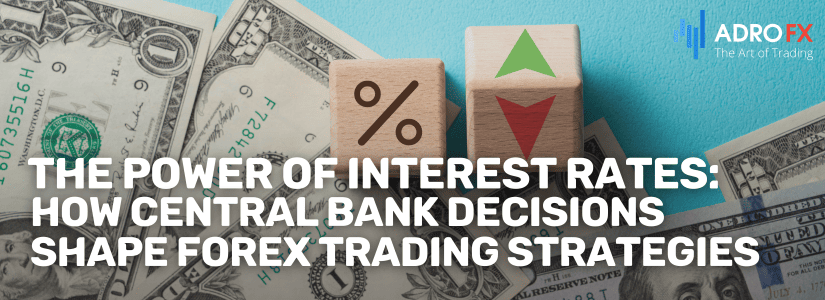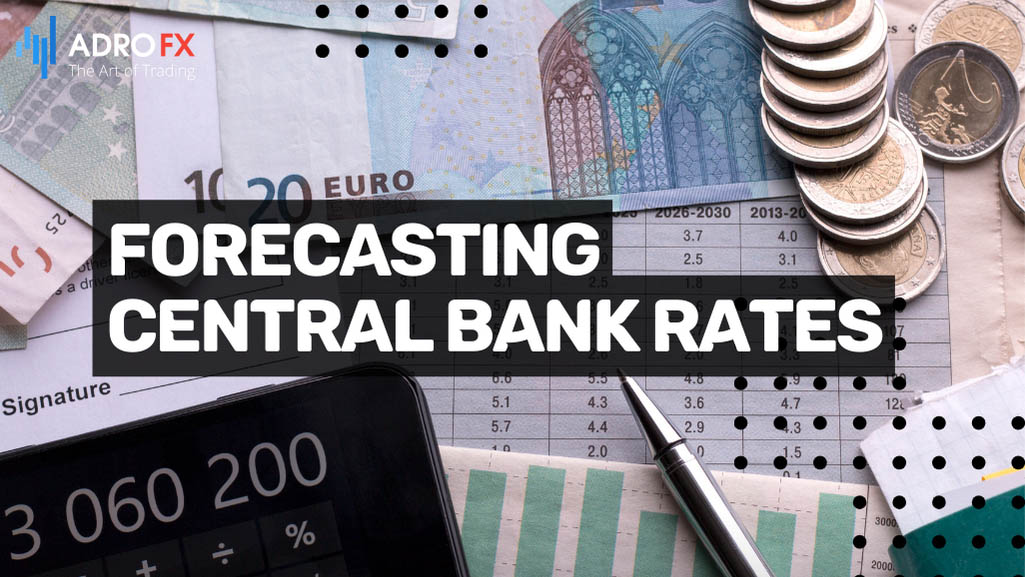The Power of Interest Rates: How Central Bank Decisions Shape Forex Trading Strategies

Understanding interest rates is fundamental to navigating the complexities of forex trading. Interest rates, which represent the cost of borrowing funds or the return on investment for lending capital, are pivotal economic indicators that shape monetary policy decisions and influence financial markets worldwide. Central banks wield significant influence over interest rates, using them as tools to regulate economic growth, control inflation, and manage employment levels. In this article, we delve into the basics of interest rates, explore how they are determined, and examine their impact on forex markets. By gaining insight into interest rate dynamics, traders can better anticipate market movements and develop effective trading strategies to navigate the dynamic landscape of forex trading.
Interest Rate Basics
Understanding interest rates is pivotal for grasping their significance in forex trading. Interest rates represent the cost of borrowing funds or the return on investment for lending capital. Central banks, such as the Federal Reserve in the United States or the European Central Bank in the Eurozone, dictate interest rates to regulate economic growth, inflation, and employment.
Essential Interest Rates
- Benchmark Rates
Central banks establish benchmark interest rates, such as the Federal Funds Rate in the US or the European Central Bank (ECB) Main Refinancing Rate in the Eurozone. These rates serve as reference points for the entire financial system, influencing interbank lending rates and subsequently affecting borrowing costs for consumers and businesses alike.
- Policy Rates
Policy rates are meticulously adjusted by central banks to finely tune the economy, managing inflation and stimulating or cooling economic activity. When policy rates are decreased, it encourages borrowing and spending, fostering economic expansion, albeit with the potential risk of inflation. Conversely, raising policy rates is a strategy to combat inflation, although it may simultaneously dampen economic growth.
- Yield Curve
The yield curve offers a nuanced depiction of the relationship between short-term and long-term interest rates. A steep yield curve typically indicates expectations of robust economic growth, with higher long-term rates reflecting optimism about future economic prospects. Conversely, a flat or inverted yield curve may signal an impending economic slowdown or recession, as it suggests that long-term interest rates are lower than short-term rates.
Understanding these core interest rate concepts is essential for navigating the intricacies of the forex market. Traders closely monitor interest rate developments and central bank policies to anticipate market movements and identify trading opportunities.

Determining a Nation's Key Interest Rates
Central banks play a pivotal role in establishing a nation's primary interest rates, which serve as fundamental drivers of economic activity and financial markets. These rates, often referred to as benchmark rates, are meticulously set through a combination of data analysis, economic forecasts, and monetary policy tools. Here's a closer look at how central banks determine a country's key interest rates:
Monetary Policy Meetings
Central banks convene regularly to assess economic conditions and set monetary policy objectives. These meetings involve comprehensive reviews of various economic indicators, including inflation, employment levels, GDP growth, and consumer spending. Based on this analysis, central bankers deliberate on whether to adjust interest rates to achieve their policy objectives.
Data Analysis
Central banks rely on a vast array of economic data to inform their interest rate decisions. Key indicators such as inflation rates, labor market statistics, industrial production, and consumer confidence surveys provide crucial insights into the state of the economy. By analyzing these data points, central bankers gauge the need for monetary stimulus or tightening measures.
Inflation Targeting
Many central banks operate under an inflation-targeting framework, where they aim to maintain stable prices by controlling inflation within a specified range. To achieve this objective, central banks may adjust interest rates to influence borrowing costs, consumer spending, and investment levels. By raising rates, central banks aim to curb inflationary pressures, while lowering rates stimulates economic activity during periods of low inflation or deflationary risks.
Forward Guidance
Central banks often provide forward guidance to communicate their monetary policy intentions to financial markets and the public. Through official statements, speeches, and press conferences, central bank officials signal their outlook on future interest rate movements based on economic projections and policy objectives. This guidance helps shape market expectations and influences investor behavior.
Overall, the process of setting a country's primary interest rates is a multifaceted endeavor that requires careful analysis of economic data, consideration of policy objectives, and effective communication with stakeholders. By judiciously adjusting interest rates, central banks aim to achieve price stability, promote sustainable economic growth, and mitigate financial risks.
The Impact of Interest Rates on Forex Markets
The choices made by central banks regarding interest rates wield significant influence over the forex market, shaping currency valuations, exchange rates, and trading approaches. Here's a breakdown of how shifts in interest rates can impact forex markets:
Currency Valuation
Differences in interest rates between nations play a pivotal role in determining the relative worth of currencies. An increase in a country's interest rates tends to strengthen its currency, as higher rates attract foreign investors seeking greater returns. Conversely, a decrease in interest rates can lead to the depreciation of the currency as investors seek higher yields elsewhere.
Exchange Rates
Changes in interest rates can directly impact exchange rates by influencing the flow of capital and demand for currencies. A higher interest rate in one country relative to another can attract capital inflows, resulting in the appreciation of the country's currency. Conversely, lower interest rates may trigger capital outflows and currency depreciation.
Strategic Carry Trades
Interest rate differentials present opportunities for carry trade strategies, where investors borrow funds in a low-interest-rate currency and invest in a higher-yielding currency. Through carry trades, investors seek to capitalize on the interest rate differential while potentially benefiting from currency appreciation. Variations in interest rate expectations can affect the feasibility and profitability of carry trades.
Guidance from Central Bank Policies
Central banks' communication and actions regarding interest rates offer valuable guidance to forex traders and investors. A hawkish monetary policy, characterized by interest rate hikes or indications of tightening measures, can strengthen a currency, while a dovish policy, signaling rate cuts or accommodative measures, may weaken it. Market participants closely monitor central bank announcements for insights into future interest rate trends.
Market Sentiment and Volatility
Interest rate decisions and their implications for monetary policy can influence market sentiment and volatility in the forex market. Uncertainty surrounding interest rate decisions, surprises in central bank announcements, or shifts in market expectations can lead to increased volatility as traders adjust their positions in response to new information.
Overall, interest rates serve as a fundamental determinant of currency values and exchange rate movements in the forex market. Forex traders meticulously analyze central bank policies, economic data releases, and interest rate expectations to anticipate market trends and position themselves effectively. By comprehending the impact of interest rates on forex markets, traders can devise informed trading strategies and manage risks adeptly.

Forecasting Central Bank Rates
Anticipating central bank interest rate decisions presents a formidable challenge, requiring a comprehensive analysis of economic indicators, central bank communications, and market sentiment. While predicting central bank rates with certainty is not feasible, market participants employ various strategies to anticipate monetary policy actions:
Analyzing Economic Indicators
Economists meticulously monitor a range of economic indicators such as inflation, GDP growth, employment data, and consumer spending to assess the health of an economy. Central banks typically adjust interest rates in response to changes in economic conditions. For instance, a surge in inflation may prompt a central bank to raise interest rates to mitigate price pressures, while sluggish economic growth might lead to rate cuts to stimulate borrowing and spending.
Interpreting Central Bank Guidance
Central banks offer forward guidance through official statements, speeches by policymakers, and minutes of policy meetings. Analysts scrutinize these communications for hints about future monetary policy actions. Hawkish statements, indicating a predisposition towards tightening monetary policy, may suggest potential interest rate hikes, while dovish remarks, signaling concerns about economic weakness, could imply forthcoming rate cuts.
Assessing Market Expectations
Market participants gauge interest rate expectations by analyzing pricing in financial markets, such as futures contracts and interest rate derivatives. The yield curve, which plots the yields of bonds with different maturities, also reflects market expectations for future interest rates. Changes in market sentiment and positioning can influence central bank decisions as policymakers evaluate the potential impact of their actions on financial markets and the broader economy.
Considering Inflation Targeting Frameworks
Many central banks operate within an inflation-targeting framework, aiming to achieve a specific inflation target over the medium term. Forecasts of inflation and deviations from the target can influence central bank rate decisions. Central banks may adjust interest rates preemptively based on inflation forecasts to maintain price stability and anchor inflation expectations.
Analyzing Global Economic Factors
Central bank decisions are influenced by global economic developments, including geopolitical events, trade tensions, and monetary policy actions by other central banks. Interdependencies between economies and financial markets mean that changes in global economic conditions can affect domestic monetary policy decisions.
While analysts employ these tools and strategies to form expectations about central bank rates, it is essential to acknowledge the inherent uncertainty and complexity involved in predicting monetary policy actions. Central banks operate independently and consider a wide range of factors in their decision-making process, making accurate predictions challenging. As a result, market participants continuously adjust their forecasts based on new information and evolving economic conditions.
Forex Interest Rate Trading Strategies
Forex interest rate trading strategies involve leveraging interest rate movements to make informed trading decisions. These strategies capitalize on fluctuations in currency prices driven by changes in interest rates and central bank policies.
In the interest rate carry trade strategy, traders borrow funds in currencies with low interest rates and invest in currencies offering higher rates. They aim to profit from the interest rate differentials, known as the "carry," while also seeking capital appreciation.
Interest rate expectation trading involves analyzing economic data, central bank communications, and market sentiment to anticipate future interest rate changes. Based on their outlook, traders take positions in currency pairs expected to appreciate or depreciate due to potential interest rate differentials.
News trading revolves around reacting to interest rate announcements and economic data releases. Traders capitalize on rapid price movements following significant news events, such as central bank rate decisions, inflation reports, or employment figures.
Range trading takes advantage of interest rate stability by trading within defined price ranges. Traders identify support and resistance levels and enter buy or sell positions when prices approach these boundaries.
Central bank policy divergence trading focuses on diverging monetary policies between central banks. Traders analyze differences in interest rate decisions to identify trading opportunities in currency pairs that reflect policy divergences.
Volatility trading involves capitalizing on increased market volatility surrounding interest rate decisions and economic events. Traders may trade currency options or employ volatility-based strategies to benefit from price fluctuations and market uncertainty.
Regardless of the chosen strategy, successful forex interest rate trading requires thorough analysis, risk management, and adaptability to changing market conditions. Traders must stay informed about economic developments, central bank policies, and geopolitical events to make informed trading decisions and manage their exposure effectively.
Conclusion
In conclusion, interest rates play a critical role in shaping the forex market landscape, driving currency values, exchange rate fluctuations, and trading strategies. Central banks' decisions regarding interest rates reflect their efforts to achieve macroeconomic objectives, such as price stability and sustainable economic growth. By understanding interest rate fundamentals, traders can interpret central bank policies, anticipate market trends, and identify trading opportunities in the forex market. Moreover, staying abreast of economic developments, central bank communications, and interest rate expectations is essential for making informed trading decisions and managing risk effectively in the ever-evolving forex market environment.
About AdroFx
Established in 2018, AdroFx is known for its high technology and its ability to deliver high-quality brokerage services in more than 200 countries around the world. AdroFx makes every effort to keep its customers satisfied and to meet all the trading needs of any trader. With the five types of trading accounts, we have all it takes to fit any traders` needs and styles. The company provides access to 115+ trading instruments, including currencies, metals, stocks, and cryptocurrencies, which make it possible to make the most out of trading on the financial markets. Considering all the above, AdroFx is the perfect variant for anyone who doesn't settle for less than the best.










